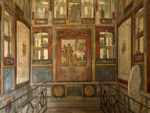 The House of the Vettii, home to one of Pompeii’s most extraordinary assemblages of frescoes, recently reopened to the public after more than two decades of closure. (It was partially reopened in 2016, allowing visitors into the entrance area and the atrium, but closed again entirely in 2019.) Visitors briefly got a chance to rub shoulders with archaeologists, architects, engineers and landscaping experts as they embarked on a comprehensive multi-disciplinary restoration project to conserve the famed wall and floor decorations, address major structural issues, renovate the colonnaded garden and install a new state-of-the-art drainage system.
The House of the Vettii, home to one of Pompeii’s most extraordinary assemblages of frescoes, recently reopened to the public after more than two decades of closure. (It was partially reopened in 2016, allowing visitors into the entrance area and the atrium, but closed again entirely in 2019.) Visitors briefly got a chance to rub shoulders with archaeologists, architects, engineers and landscaping experts as they embarked on a comprehensive multi-disciplinary restoration project to conserve the famed wall and floor decorations, address major structural issues, renovate the colonnaded garden and install a new state-of-the-art drainage system.
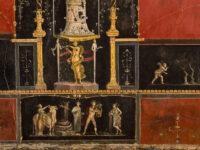 Some of the more challenging aspects of the conservation involved fixing previous well-intended interventions gone awry over time. The concrete roof added in the 1950s to protect the villa’s remains from the elements was now exacerbating water penetration. Layers of wax applied to the frescoes for their protection and to give them a glossy sheen had to be painstakingly removed to restore the visibility of the of the magnificent detail in the architectural and mythological motifs.
Some of the more challenging aspects of the conservation involved fixing previous well-intended interventions gone awry over time. The concrete roof added in the 1950s to protect the villa’s remains from the elements was now exacerbating water penetration. Layers of wax applied to the frescoes for their protection and to give them a glossy sheen had to be painstakingly removed to restore the visibility of the of the magnificent detail in the architectural and mythological motifs.
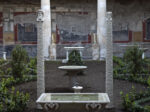 The peristyle garden was restored with careful attention to the original plant species that grew there. Marble fountains, basins, pilasters and statues discovered in the garden of the villa in 19th century excavations are in the Naples National Archaeological Museum, but fine copies have now been installed in the garden to recreate its sumptuous hardscaping.
The peristyle garden was restored with careful attention to the original plant species that grew there. Marble fountains, basins, pilasters and statues discovered in the garden of the villa in 19th century excavations are in the Naples National Archaeological Museum, but fine copies have now been installed in the garden to recreate its sumptuous hardscaping.
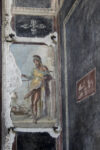 Another major renovation correcting a former misguided curatorial approach that was once common: locking up sexually explicit Roman art and artifacts behind closed doors to spare the weak sensibilities of women, children and the lower classes. Only gentlemen were deemed to have the moral fortitude to withstand the view of mighty erections and fornication in every position. They alone would be allowed into the locked Secret Cabinets where museums hid all the phalluses and deities mid-coitus that the Romans had displayed with pride, like the iconic fresco of Priapus weighing his erection against a pile of coins which welcomed all visitors at the front entrance of the villa.
Another major renovation correcting a former misguided curatorial approach that was once common: locking up sexually explicit Roman art and artifacts behind closed doors to spare the weak sensibilities of women, children and the lower classes. Only gentlemen were deemed to have the moral fortitude to withstand the view of mighty erections and fornication in every position. They alone would be allowed into the locked Secret Cabinets where museums hid all the phalluses and deities mid-coitus that the Romans had displayed with pride, like the iconic fresco of Priapus weighing his erection against a pile of coins which welcomed all visitors at the front entrance of the villa.
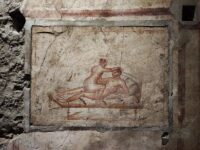 In the case of the House of the Vettii, a room adjacent to the kitchen in the servants’ area of the villa was decorated with erotic wall paintings. Archaeologists believe it was used for prostitution, a hypothesis confirmed by the discovery of an inscription offering a “Greek and well-mannered” woman named Eutychis for the bargain price of two asses. An iron door was added in the 19th century and kept locked with access to the room only allowed upon request of men whose monocles were primed and ready to pop. That door has at long last been removed.
In the case of the House of the Vettii, a room adjacent to the kitchen in the servants’ area of the villa was decorated with erotic wall paintings. Archaeologists believe it was used for prostitution, a hypothesis confirmed by the discovery of an inscription offering a “Greek and well-mannered” woman named Eutychis for the bargain price of two asses. An iron door was added in the 19th century and kept locked with access to the room only allowed upon request of men whose monocles were primed and ready to pop. That door has at long last been removed.
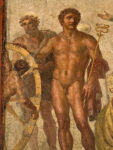 But it’s the frescoes in the main rooms of the house that are the real money shots of the House of the Vettii, and this video tour led by historian Darius Arya for Ancient Rome Live captures their intense color and dazzling detail beautifully. He also does an excellent job at explaining the mythological scenes and how they connect to the personal histories of homeowners Aulus Vettius Restitutus and Aulus Vettius Conviva, freedmen brothers who became wealthy merchants and rose high in the city’s social ranks.
But it’s the frescoes in the main rooms of the house that are the real money shots of the House of the Vettii, and this video tour led by historian Darius Arya for Ancient Rome Live captures their intense color and dazzling detail beautifully. He also does an excellent job at explaining the mythological scenes and how they connect to the personal histories of homeowners Aulus Vettius Restitutus and Aulus Vettius Conviva, freedmen brothers who became wealthy merchants and rose high in the city’s social ranks.
This video captures overhead views that include the new roof that drains properly and the meticulous restoration of the interiors.